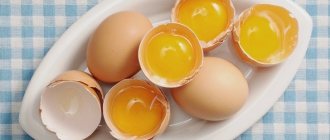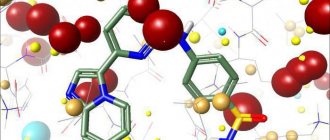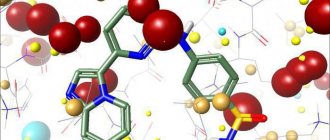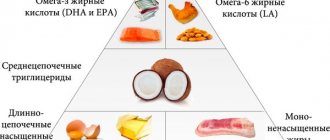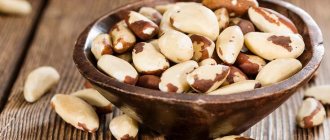Hello friends! Let's talk about protein in foods today.
I decided to write a series of posts about what, in my understanding, is a proper balanced diet and talk about how I eat.
I, like many people moving in the direction of a healthy lifestyle, had a long path to my current diet.
There were a lot of mistakes and misconceptions in it. The conclusion that I have made for myself now, in my opinion, is correct.
In order to come to him, I had to take courses in nutrition and dietetics, read a lot of interesting literature, and get acquainted with a variety of diets and nutrition trends.
And then systematize all this and formulate for yourself your own nutrition system, based on the recommendations of Soviet nutritionists and new discoveries of modern nutritionists.
In no way do I encourage anyone to eat the way I write.
I just want to share my experience with you and maybe it will be useful to someone.
So, I’ll start with the most important topic and the most important component of food - proteins.
Why are they needed, where is protein found in foods, how much protein should be consumed in food, and what threatens us with protein deficiency.
I will not delve into complex terms and descriptions now, but I will try to tell you about the complex in simple language.
What is protein
Proteins (proteins/polypeptides) are organic substances, natural polymers containing twenty interconnected amino acids. The combinations provide many views. The body copes with the synthesis of twelve essential amino acids on its own.
Eight of the twenty essential amino acids found in protein cannot be independently synthesized by the body; they are obtained from food. These are valine, leucine, isoleucine, methionine, tryptophan, lysine, threonine, and phenylalanine, which are important for life.
Levels of organization
Based on levels of organization, proteins are divided into four structures:
- primary;
- secondary;
- tertiary;
- quaternary
Primary protein structure
The primary structure is an elementary linear amino acid chain connected by a polypeptide bond. A feature of this structure is a stabilized connection of residual parts of the amino acid that perform special functions in the composition of proteins.
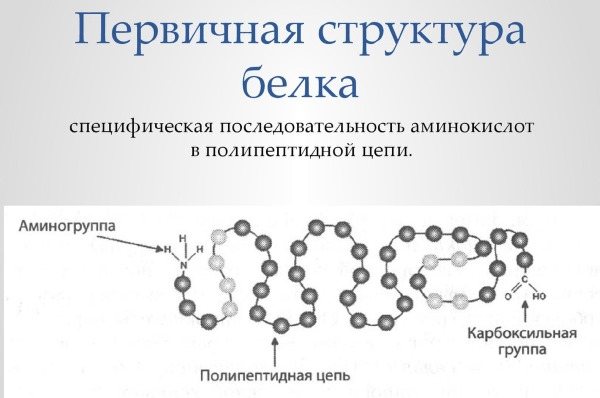
The primary structure is determined by the sequential placement of amino acid or nucleotide combinations using tabular data of the genetic code.
Protein secondary structure
Secondary structure is a method of forming an ordered chain of elementary compounds using the group interaction of amino acid substances bonded by hydrogen bonds. There are 2 options for the secondary structure: spiral (rope) and folded (accordion). Both types are found in proteins, but the proportions are different.
Protein tertiary structure
Tertiary structure - components of the secondary structure, which are connected by various interacting processes with an isolating function from water. This structure can be determined through X-ray diffraction analysis or microscopy.
Quaternary protein structure
Quaternary structure is a combination of several amino acid compounds in one protein after its complete processing in the body. The same types of relationships take part in the formation of the quaternary and tertiary levels.
What kind of protein is there?
There are animal and plant (based on origin). Two types are required.
Animal:
- Meat;
- Fish;
- Milk products;
- Eggs.
Egg white is easily and almost completely absorbed by the body (90-92%). The proteins of fermented milk products are slightly worse (up to 90%). The proteins of fresh whole milk are absorbed even less (up to 80%). The value of beef and fish is in the best combination of essential amino acids.
Vegetable:
- Cereals, cereals;
- Legumes;
- Soy;
- Nuts;
- Fruits.
Soybeans, rapeseed and cottonseeds have a good ratio of amino acids for the body. In grain crops this ratio is weaker.
There is no product with an ideal amino acid ratio. Proper nutrition involves a combination of animal and plant proteins.
The basis of nutrition “according to the rules” is animal protein. It is rich in essential amino acids and ensures good absorption of plant protein.
Classification by type of structure
Based on the type of structure, proteins are divided into simple and complex. Simple proteins are proteins that contain amino acid residues (the main components of protein). Found in eggs, milk, beans and plant crops.
Complex proteins are proteins that contain a main protein component and a non-protein component (acids, fats, carbohydrates), during the interaction of which vital cycles of human development and strengthening occur.
Several types of complex proteins have been identified depending on their composition:
- Glycoproteins - consist of amino acids and carbohydrates.
- Nucleoproteins are a union of amino acids and nucleic acids.
- Lipoproteins are the interaction of the main protein component and fats.
- Phosphorus proteins - the composition contains amino acid and phosphoric acid.
- Chromoproteins are the interaction of protein substances and metal-containing elements.

Proteins are also divided into animal proteins - found in the meat of animals, their blood and skin and supporting tissues, and plant proteins - found in plant crops.
Functions of protein in the body
Being in tissue cells, it performs many functions:
- Protective. The functioning of the immune system is the neutralization of foreign substances. Antibodies are produced.
- Transport. Supply of various substances, for example, hemoglobin (oxygen supply).
- Regulatory. Maintaining hormonal levels.
- Motor. All types of movement are provided by actin and myosin.
- Plastic. The condition of connective tissue is controlled by collagen content.
- Catalytic. It is a catalyst and accelerates the passage of all biochemical reactions.
- Preservation and transmission of genetic information (DNA and RNA molecules).
- Energy. Supplying the entire body with energy.
Others provide breathing, are responsible for the digestion of food, and regulate metabolism. The light-sensitive protein rhodopsin is responsible for visual function.
Blood vessels contain elastin, thanks to which they function fully. The protein fibrinogen ensures blood clotting.
Proper protein nutrition for the body
Proteins are the main element for the development, renewal and normalization of the functioning of the body.
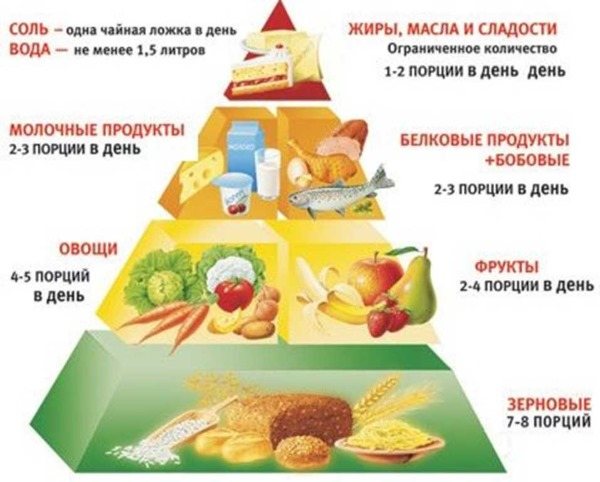
To maintain the beauty and health of the body, it is necessary to follow the rules of protein nutrition daily:
- Eat protein foods for breakfast, lunch and dinner in the required quantities, taking into account your lifestyle, age and gender.
- Increase protein intake depending on the desired result. Athletes need more of it to gain muscle mass, while those losing weight need less.
- Monitor protein balance, the violation of which leads to poor health and impaired organ functionality.
- Maintain a drinking regime, drink at least 1.5 liters of water per day. It is involved in all human life support processes and speeds up metabolism.
- Protein must enter the body from both animal and plant foods. Depending on its origin, protein differs in its functional effects on the body.
Symptoms of lack of protein in the body
Protein deficiency is a fairly common occurrence due to poor nutrition and the hyperactive lifestyle of modern people. In a mild form, it is expressed in regular fatigue and deterioration in performance. As insufficient amounts increase, the body signals through symptoms:
- General weakness and dizziness. Decreased mood and activity, the appearance of muscle fatigue without much physical activity, deterioration in coordination of movements, weakening of attention and memory.
- The appearance of headaches and worsening sleep. Insomnia and anxiety indicate a lack of serotonin.
- Frequent mood swings, grouchiness. A lack of enzymes and hormones provokes depletion of the nervous system: irritability for any reason, unreasonable aggressiveness, emotional incontinence.
- Pale skin, rashes. With a lack of iron-containing protein, anemia develops, the symptoms of which are dry and pale skin and mucous membranes.
- Swelling of the limbs. Low protein content in blood plasma disrupts the water-salt balance. Subcutaneous fat accumulates fluid in the ankles and ankles.
- Poor healing of wounds and abrasions. Cell restoration is inhibited due to a lack of “building material”.
- Brittle and hair loss, brittle nails. The appearance of dandruff due to dry skin, peeling and cracking of the nail plate is the most common signal from the body about a lack of protein. Hair and nails are constantly growing and instantly react to the lack of substances that promote growth and good condition.
- Unreasonable weight loss. The disappearance of kilograms for no apparent reason is due to the body’s need to compensate for the lack of protein through muscle mass.
- Failure of the heart and blood vessels, the appearance of shortness of breath. The functioning of the respiratory, digestive, and genitourinary systems also deteriorates. Shortness of breath appears without physical exertion, cough without colds and viral diseases.
With the appearance of symptoms of this kind, you should immediately change the diet and quality of food, reconsider your lifestyle, and if they worsen, consult a doctor.
Beneficial properties of protein and its effect on the body
Depending on their specialization, proteins perform various functions in the body. Transport proteins, for example, deliver vitamins, fat and minerals to all cells of the body. Catalyst proteins accelerate various chemical processes occurring in the body. There are also proteins that fight various infections, being antibodies to various diseases. In addition, proteins are sources of important amino acids, which are necessary as building materials for new cells and strengthening existing ones.
Interaction with essential elements
Everything in nature is interconnected, and everything also interacts in our body. Proteins, as part of the overall ecosystem, interact with other elements of our body - vitamins, fats and carbohydrates. Moreover, in addition to simple interaction, proteins are also involved in the transformation of one substance into another.
As for vitamins, for every gram of protein consumed, you need to consume 1 mg of vitamin C. If there is a lack of vitamin C, only the amount of protein that is enough for the vitamin contained in the body will be absorbed.
Dangerous properties of proteins and warnings
Signs of lack of protein in the body
- Weakness, lack of energy. Loss of performance.
- Decreased libido. Medical tests may reveal a deficiency of certain sex hormones.
- Low resistance to various infections.
- Violation of the functions of the liver, nervous and circulatory systems, functioning of the intestines, pancreas, metabolic processes.
- Muscle atrophy develops, growth and development of the body in children slows down.
Signs of excess protein in the body
- Fragility of the skeletal system, resulting from acidification of the body, which leads to the leaching of calcium from the bones.
- Impaired water balance in the body, which can also lead to swelling and inability to absorb vitamins.
- The development of gout, which in the old days was called “rich people’s disease,” is also a direct consequence of excess protein in the body.
- Excess weight can also be a consequence of excessive protein consumption. This is due to the activity of the liver, which converts excess protein for the body into adipose tissue.
- Colon cancer, according to some scientific sources, can be a consequence of the increased content of purines in food.
Factors influencing protein content in the body
Composition and quantity of food .
Since the body cannot synthesize essential amino acids on its own. Age. It is known that in childhood the amount of protein necessary for the growth and development of the body is more than 2 times higher than the protein requirement of a middle-aged person! In old age, all metabolic processes proceed much more slowly, and, consequently, the body’s need for proteins is significantly reduced.
Physical labor and professional sports . To maintain tone and performance, athletes and people engaged in intense physical labor require a 2-fold increase in protein intake, since all metabolic processes occur very intensively in their body.
Protein food for health

As we have already said, there are 2 large groups of proteins: proteins that are sources of nonessential and essential amino acids. There are only 9 essential amino acids: threonine, methionine, tryptophan, lysine, leucine, isoleucine, phenylalanine, valine. It is these amino acids that our body especially needs, since they are absorbed only from food.
In modern dietetics there is such a thing as complete and incomplete protein . A protein food that contains all the essential amino acids is called a complete protein; an incomplete protein is a food that contains only some of the essential amino acids.
Foods containing complete, high-quality protein include meat, dairy, seafood and soy. The top spot in the list of such products belongs to eggs, which, according to medical criteria, are considered the gold standard of complete protein.
Incomplete protein is most often found in nuts, various seeds, cereals, vegetables, legumes, and some fruits.
By combining foods containing incomplete protein with complete protein in one meal, you can achieve maximum absorption of incomplete protein. To do this, it is enough to include only a small amount of animal products in your diet, and the benefits for the body will be significant.
Protein and vegetarianism

Some people, due to their moral and ethical convictions, completely excluded meat products from their diet. The most famous of them are Richard Gere, the Blue Lagoon star Brooke Shields, the magnificent Pamela Anderson, and the unrivaled Russian comedian Mikhail Zadornov.
However, in order for the body not to feel deprived, a complete replacement for fish and meat is necessary. For those who consume milk, cottage cheese, and eggs, it is, of course, easier. Those who have completely abandoned animal proteins have to be very creative so that the body does not suffer from a lack of protein. This is especially true for children’s fast-growing organisms, which, with a lack of amino acids, can slow down growth and normal development.
Thanks to certain studies related to the study of the absorption of plant protein by the body, it became known that certain combinations of such protein can provide the body with a full set of essential amino acids. These combinations are: mushrooms-cereals; mushrooms-nuts; legumes–cereals; legumes – nuts, as well as different types of legumes, combined in one meal.
But this is just a theory and it will take time before it is fully confirmed or refuted.
Among plant protein products, the title of “champion” in terms of protein content goes to soy. 100 grams of soy contains more than 30% complete protein. Japanese miso soup, soy meat and soy sauce are not all the delicacies that are prepared from this amazing product. Mushrooms, lentils, beans and peas contain from 28 to 25% incomplete protein per 100 grams.
Avocado is comparable in protein content to fresh cow's milk (it contains about 14% protein). In addition, the fruit contains Omega-6 polyunsaturated fatty acids and dietary fiber. Nuts, buckwheat, Brussels sprouts and cauliflower, as well as spinach and asparagus complete our list of foods rich in plant protein.
Proteins in the fight for slimness and beauty
For those who want to always remain fit and beautiful, nutritionists recommend adhering to a certain diet before and after training:
- 1 In order to build muscle mass and get an athletic figure, it is recommended to eat protein foods an hour before training. For example, half a plate of cottage cheese or another fermented milk product, chicken breast or turkey with rice, fish with salad, omelet with oatmeal.
- 2 To achieve an athletic figure , eating is allowed within 20 minutes after training. Moreover, you should eat protein and carbohydrate foods, but not fats.
- 3 If the goal of the workout is to gain slimness and grace, without building muscle mass, then protein foods should be consumed no earlier than 2 hours after the end of the workout. Before training, do not eat protein for 5 hours at all. Last meal (carbohydrates) 2 hours before class.
- 4 And now about maintaining proper metabolism in the body. According to nutritionists, it is recommended to consume proteins in the afternoon. They maintain a feeling of fullness for a long time, and this is an excellent prevention of heavy night meals.
- 5 Beautiful skin, lush and shiny hair, strong nails are the result of a sufficient amount of essential amino acids in the diet, acting in conjunction with vitamins and microelements.
We have collected the most important points about squirrels in this illustration and will be grateful if you share the picture on a social network or blog with a link to this page:
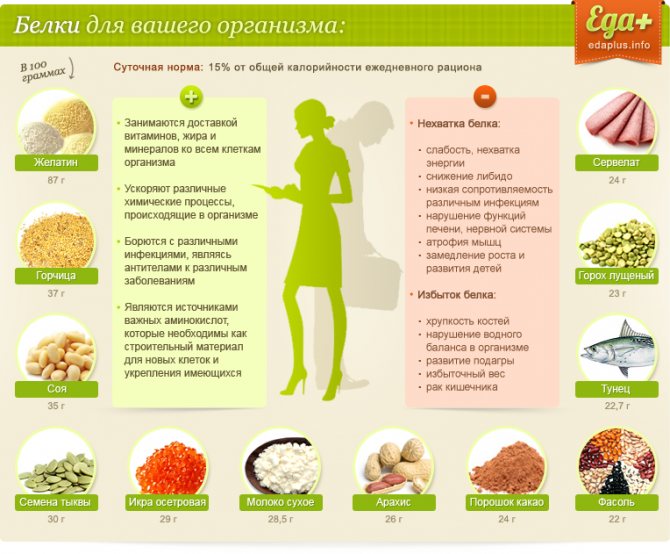
Tatyana Eliseeva chief editor of the Food+ project
Ask a Question
Rating:
9.4
/10
Votes: 36
Usefulness of material 10
Reliability of information 8.4
Formatting of Article 9.7
How much protein is needed for absorption?
The daily consumption rate depends on age, gender, and type of work activity. Data on norms are presented in the table (below) and are calculated for normal weight. It is not necessary to split your protein intake into several doses. Everyone determines the form that is convenient for themselves, the main thing is to maintain the daily intake.
| Work activity + physical activity | Age period | Protein intake per day, g | |||
| For men | For women | ||||
| Total | Animal origin | Total | Animal origin | ||
| Without load | 18-40 | 96 | 58 | 82 | 49 |
| 40-60 | 89 | 53 | 75 | 45 | |
| Minor degree | 18-40 | 99 | 54 | 84 | 46 |
| 40-60 | 92 | 50 | 77 | 45 | |
| Average degree | 18-40 | 102 | 58 | 86 | 47 |
| 40-60 | 93 | 51 | 79 | 44 | |
| High degree | 18-40 | 108 | 54 | 92 | 46 |
| 40-60 | 100 | 50 | 85 | 43 | |
| Periodic | 18-40 | 80 | 48 | 71 | 43 |
| 40-60 | 75 | 45 | 68 | 41 | |
| Retirement age | 75 | 45 | 68 | 41 | |
Protein standards for an adult
The average protein requirement for an adult is 85g per day with moderate activity. Protein is absorbed by the body 80% from animal foods and 60% from plant foods. The norm of protein consumption of an individual is calculated based on two factors: the person’s weight and his physical activity.
For example:
- With a sedentary lifestyle, the protein requirement is 1g per 1kg of weight.
- For average exercise (going to the gym 1-2 times a week or active recreation on weekends, daily walking) – 2g per 1kg of weight.
- For heavy training and intense work – 3g per 1 kg of person’s weight.
Protein consumption rates also depend on the individual characteristics of the individual. Everyone can control the amount of use of the desired substance themselves, listening to personal needs and paying attention to signs and symptoms.
High protein content in products
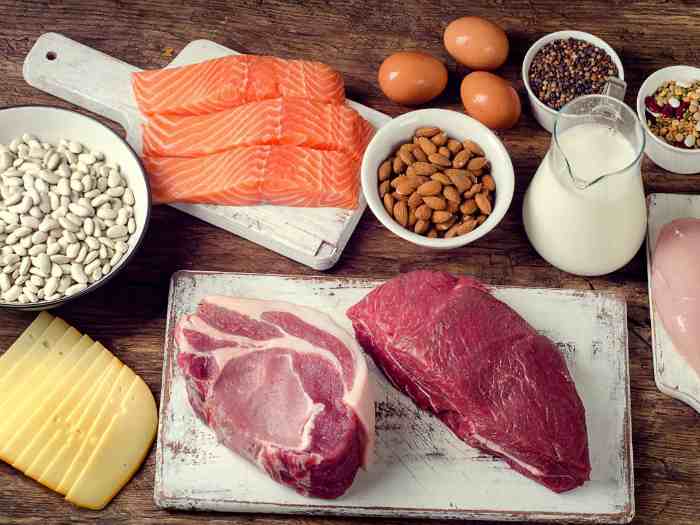
Recognized Protein Products:
- Poultry meat. Contents 17÷22 g (per 100 g);
- Other meat: 15÷20 g;
- Fish: 14÷20 g;
- Seafood: 15÷18 g;
- Legumes: 20÷25 g;
- Any nuts: 15÷30 g;
- Eggs: 12 g;
- Hard cheeses: 25÷27 g;
- Cottage cheese: 14÷18 g;
- Cereals: 8÷12 g;
Of all types of meat, beef will be in first place after poultry in terms of content: 18.9 g. After it, pork: 16.4 g, lamb: 16.2 g.
Among seafood, the leaders are squid and shrimp: 18.0 g. The richest fish in protein is salmon: 21.8 g, then pink salmon: 21 g, pike perch: 19 g, mackerel: 18 g, herring: 17.6 g and cod: 17.5 g.
Among dairy products, the positions are firmly held by kefir and sour cream: 3.0 g, then milk: 2.8 g. High-content cereals - Hercules: 13.1 g, millet: 11.5 g, semolina: 11.3 g.
Knowing the norm and taking into account financial capabilities, you can competently create a menu and be sure to supplement it with fats and carbohydrates.
Signal function
All receptors of our sense organs have a protein structure. The perception of all information from the environment, its further transmission through the central nervous system and the body's response to any stimulus are impossible without certain substances of a protein nature.
For example, endorphins are a necessary part of the response to stress, as they have an analgesic effect, help the body adapt to a stressful situation, and improve memory and learning.
Protein ratio in diet
The proportion of proteins, fats, carbohydrates in a healthy diet should be (in grams) 1:1:4. The key to balancing a healthy dish can be presented differently: proteins 25-35%, fats 25-35%, carbohydrates 30-50%.
At the same time, fats should be healthy: olive or flaxseed oil, nuts, fish, cheese.
Carbohydrates on the plate include durum pasta, any fresh vegetables, as well as fruits/dried fruits, and dairy products.
Proteins per serving can be combined as desired: plant + animal.
Veganism and powerlifting (Grigory Tocheny)
What if you give up animal protein completely? In fact, the origin of the protein - animal or plant - is not so important. The main thing is the overall amino acid profile, which must be complete.
A famous blogger, vegan and powerlifter shared with us data on protein consumption. Vegans are people who do not consume animal protein for ethical reasons. All protein in a vegan diet comes from plants. The amount of protein given below allows Grigory Tocheny [20] to perform heavy training with iron and progress in results.
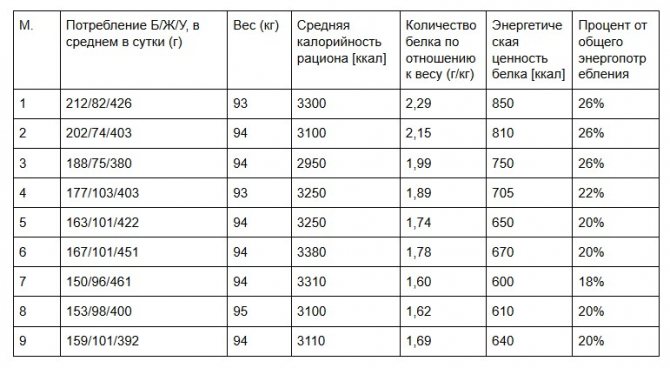
Amino acids contained in protein
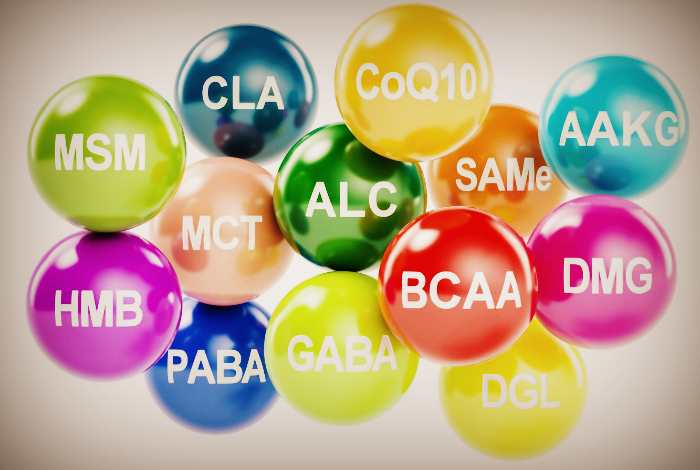
Replaceable ones can be synthesized by the body itself, but their supply from the outside is never superfluous. Especially with an active lifestyle and heavy physical activity.
All of them are important, without exception, the most popular of them are:
Alanin. Stimulates carbohydrate metabolism, promotes the elimination of toxins. Responsible for “cleanliness”. High content in meat, fish, dairy products.
Arginine . Necessary for the contraction of any muscles, healthy skin, cartilage and joints. Ensures fat burning and immune system function. Found in any meat, milk, any nuts, gelatin.
Aspartic acid. Provides energy balance. Improves the functionality of the central nervous system. Beef and chicken dishes, milk, and cane sugar replenish energy resources well. Contained in potatoes, nuts, cereals.
Histidine. The main “builder” of the body is transformed into histamine and hemoglobin. Quickly heals wounds and is responsible for growth mechanisms. Relatively high in milk, cereals and any meat.
Serin. A neurotransmitter, indispensable for the smooth functioning of the brain and central nervous system. Found in peanuts, meat, cereals, soybeans.
With proper nutrition and a proper lifestyle, the body will have all the amino acids for the synthesis of “cubes” and modeling health, beauty and longevity.
The virus is here and now
The PCR test (throat swab) is currently the main method for diagnosing COVID-19. It detects the RNA of the virus and gives a verdict: is there an infection in the body here and now. If the result is positive, a repeat test will be required after 14 days (to cancel the quarantine regime).
Why give it up ? To detect coronavirus infection or lack thereof. Such an analysis may be necessary to easily check into a hotel or enter another country, as well as to avoid quarantine upon returning from long trips.
Question answer
Why do you still need to take a PCR test after getting vaccinated against coronavirus?
How long to wait for the result ?
A regular analysis will be ready within 1-2 days. Supersensitive - within 12-24 hours. Extra urgent - 4 hours. The result of the antigen test will be known within 15 minutes (in this case, not the RNA of the virus is detected, but its antigen). Where to submit? Biomaterial can be submitted to the laboratory in person or sent by courier. But in this case, the patient himself will be responsible for the correct collection of material. When performing a test at home, a negative result does not always guarantee the absence of coronavirus. In addition, in the early stages of the disease, the likelihood of obtaining a false negative result increases. Storage rules and expiration dates must also be observed. As a result, having a negative rapid test in hand, you often have to go back to the laboratory and get tested according to all the rules.
What does a lack of protein in the body lead to?
- Frequent infectious diseases, weakened immune system.
- Stress and anxiety.
- Aging and slowdown of all metabolic processes.
- Side effect from the use of certain medications.
- Malfunctions of the gastrointestinal tract.
- Injuries.
- Meals based on fast food, instant products, and low-quality semi-finished products.
A deficiency of any one amino acid will stop the production of a particular protein. The body is designed on the principle of “filling voids”, so the missing amino acids will be extracted from other proteins. This “rearrangement” disrupts the functioning of organs, muscles, heart, brain and subsequently provokes disease.
Protein deficiency in children inhibits growth and causes physical and mental disabilities. The development of anemia, the appearance of skin diseases, pathologies of bone and muscle tissue is not a complete list of diseases. Severe protein dystrophy can result in marasmus and kwashiorkor (a type of severe dystrophy due to a lack of proteins).
Regulatory function
Hormones are substances that regulate the growth, development and differentiation of various organs and tissues, determine physical, sexual and mental development.
Hormones play a primary role in the processes of human adaptation to environmental conditions.
Many hormones are protein substances. For example, insulin, a pancreatic hormone, regulates carbohydrate metabolism. Under the influence of insulin, the concentration of glucose in the blood decreases and glucose is converted into glycogen in the liver and muscles.
Hormones produced by the pituitary gland, an endocrine gland that is connected to one of the parts of the brain, also have a protein structure. The pituitary gland is a kind of “command post” for regulating the activity of all endocrine glands.
Transport function
Some types of proteins perform a transport function. They bind and transport individual molecules inside the cell or even from organ to organ.
For example, red blood cell hemoglobin (protein), when blood passes through the lungs, binds oxygen and delivers it to all organs and tissues. This begins the process of intracellular oxidation, during which the energy necessary for the functioning of the body is released.
In the blood plasma, the transport function is carried out by lipoproteins, transferring lipids from the liver to other organs.
Cell membranes contain proteins that can bind glucose, amino acids, vitamins, hormones, and drugs, and ensure their active transport into the cell.


